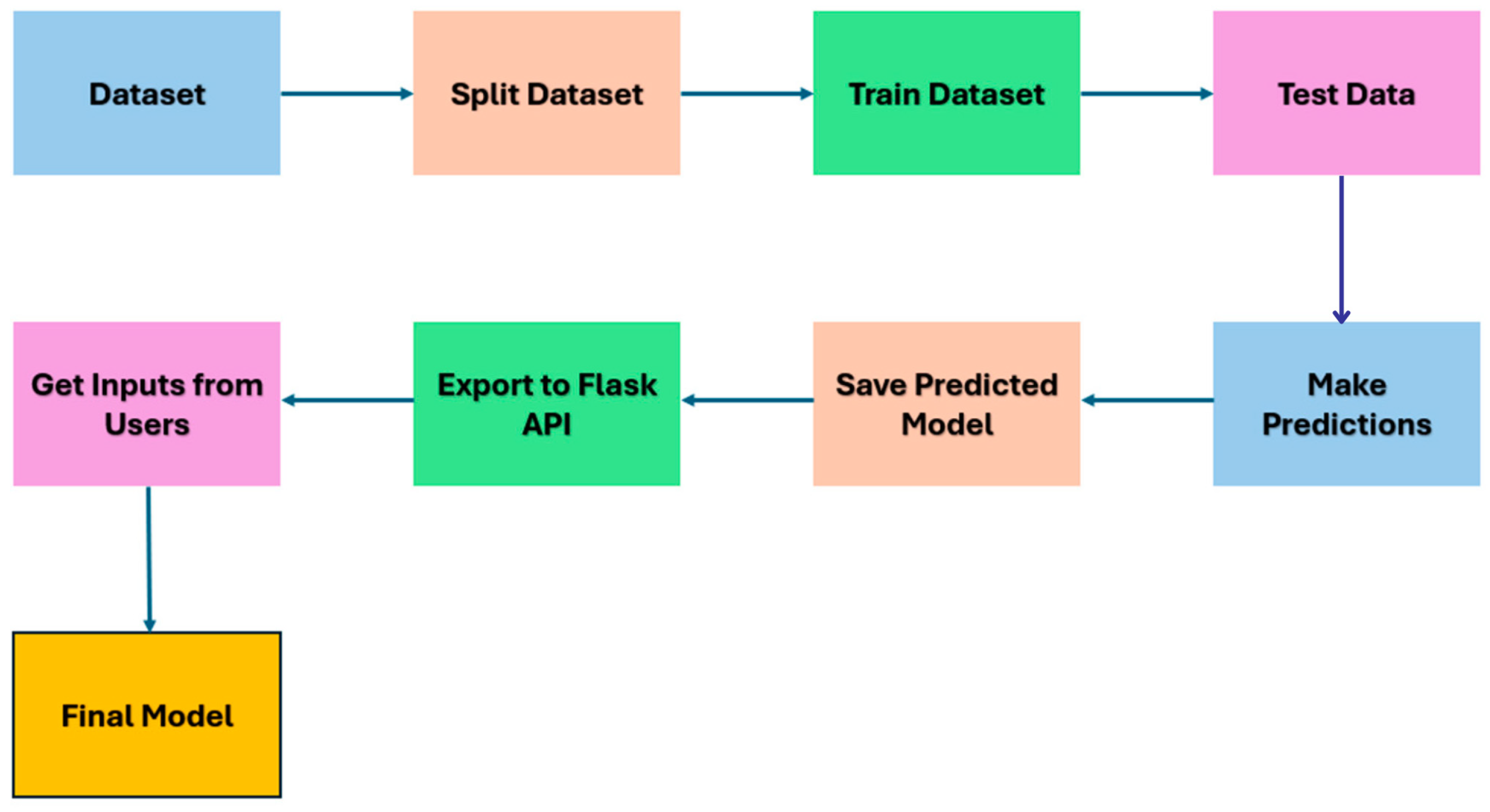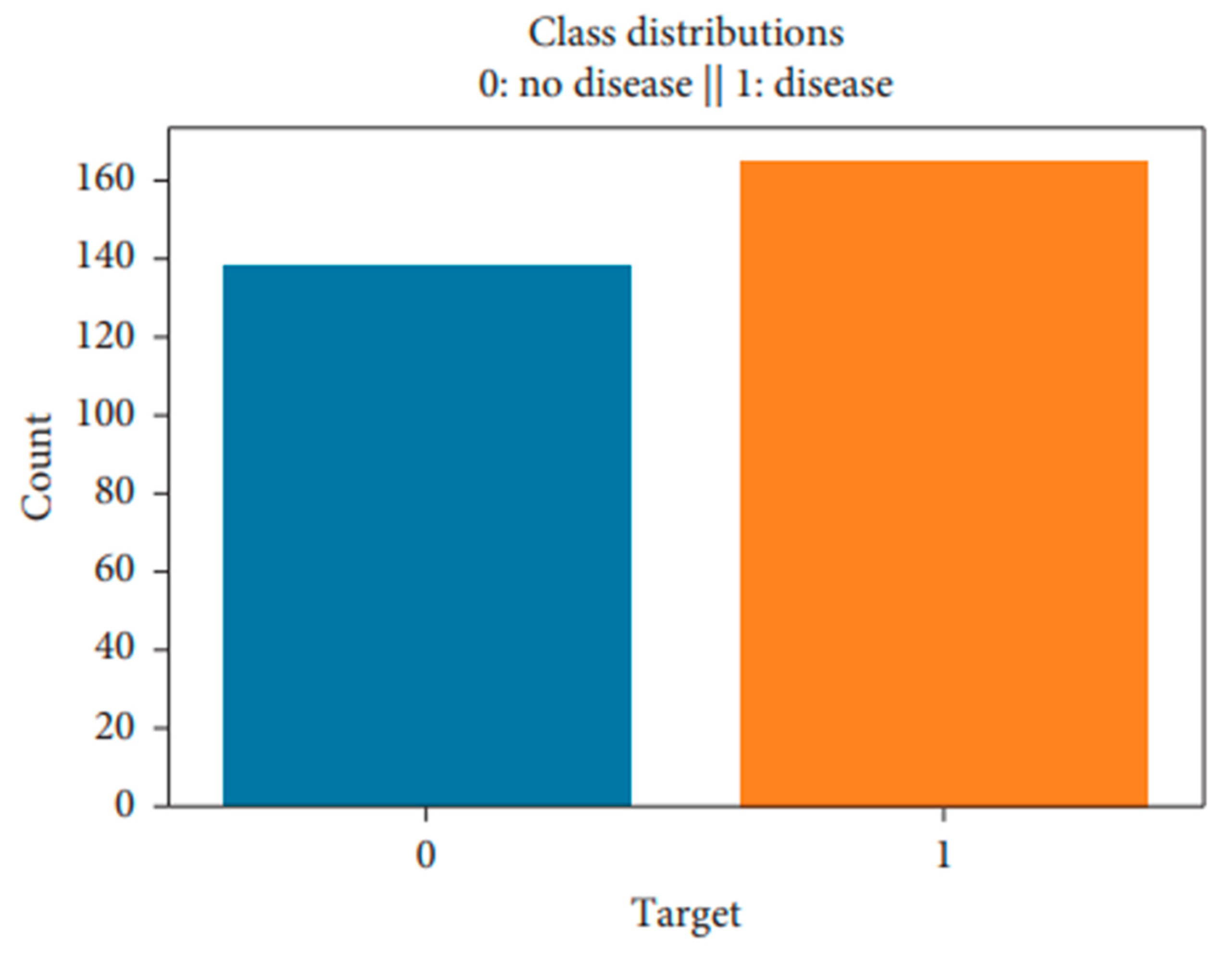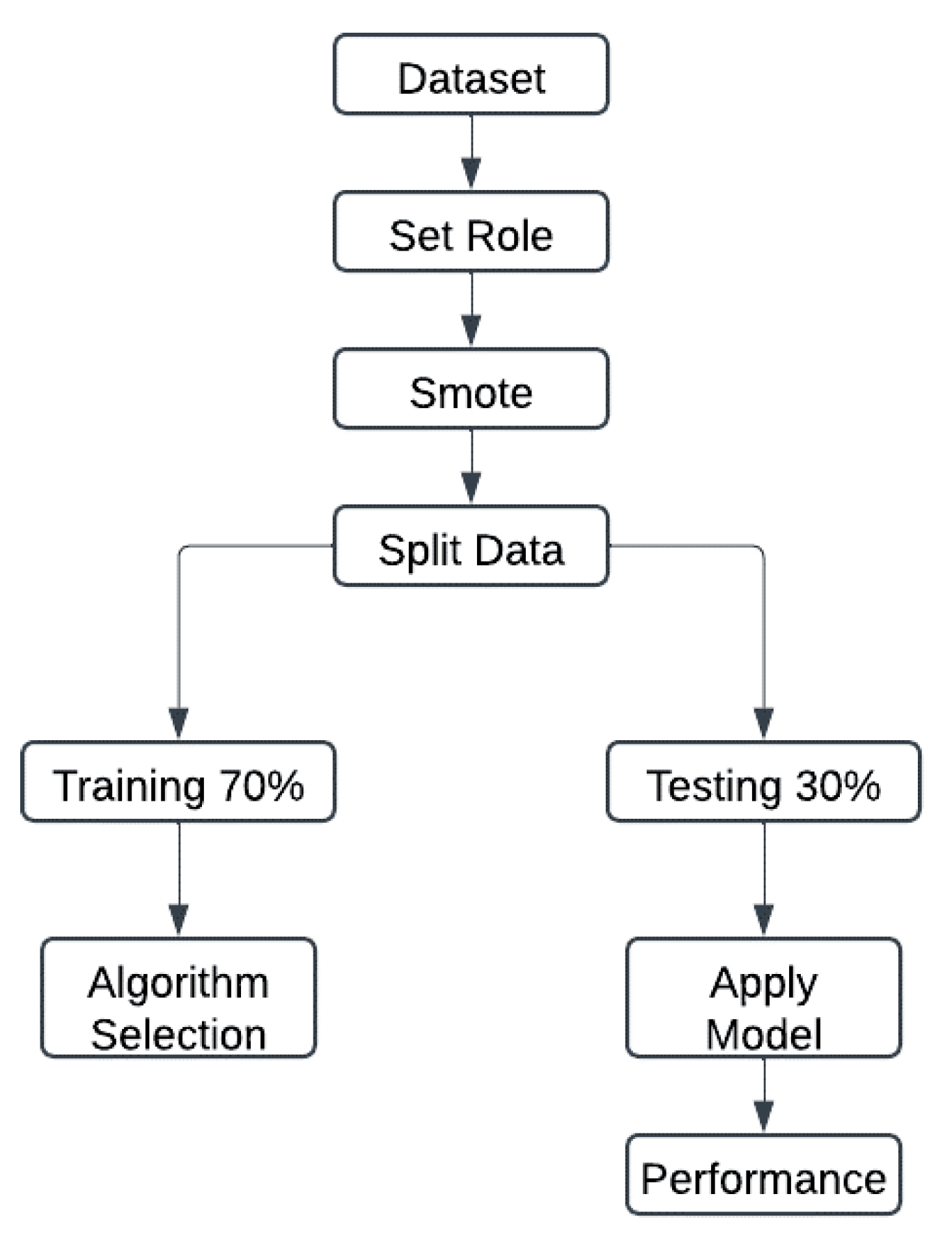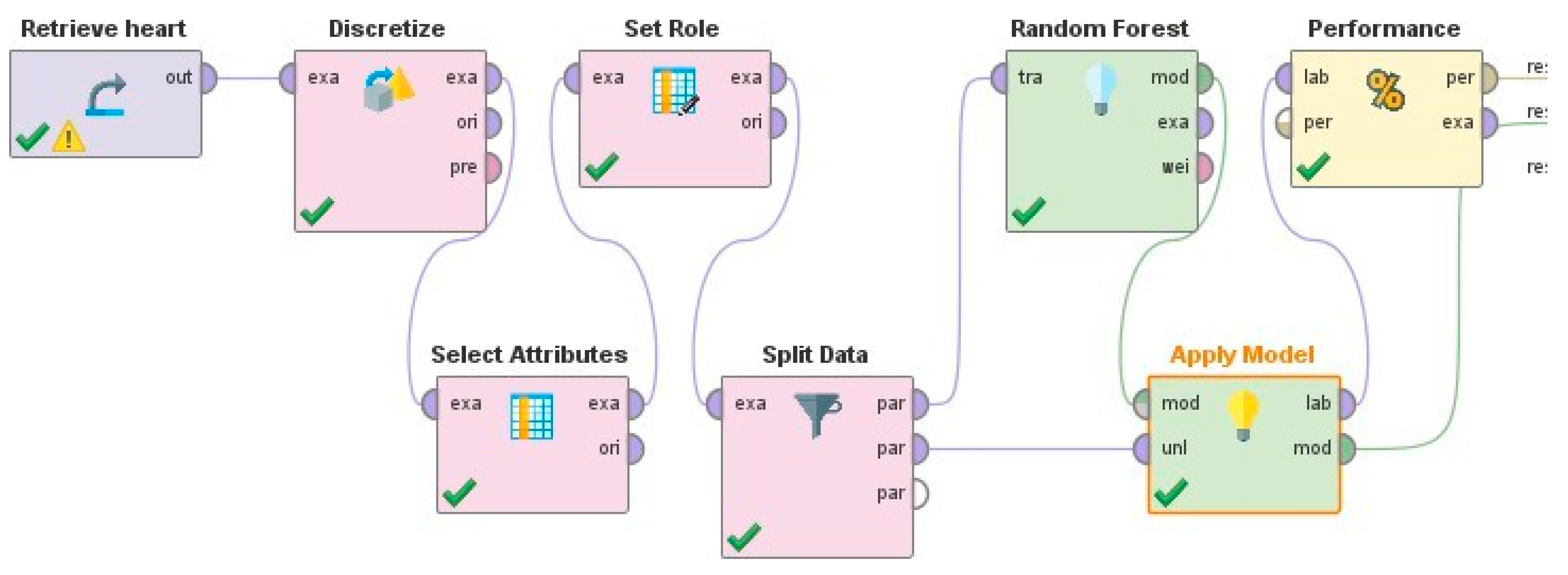Heart Disease Prediction Using ML †
Abstract
1. Introduction
2. Literature Review
3. Methodology
3.1. Classification Algorithms
3.2. Random Forest
3.3. KNN
3.4. Naïve Bayes
3.5. Decision Tree
4. Results
5. Conclusions and Future Research Directions
Author Contributions
Funding
Institutional Review Board Statement
Informed Consent Statement
Data Availability Statement
Conflicts of Interest
References
- Ahmad, G.N.; Fatima, H.; Ullah, S.; Saidi, A.S.; Imdadullah. Efficient Medical Diagnosis of Human Heart Diseases Using Machine Learning Techniques with and Without GridSearchCV. IEEE Access 2022, 10, 80151–80173. [Google Scholar] [CrossRef]
- Airehrour, D.; Gutierrez, J.; Kumar Ray, S. GradeTrust: A Secure Trust Based Routing Protocol for MANETs. In Proceedings of the 25th International Telecommunication Networks and Applications Conference (ITNAC), Sydney, Australia, 18–20 November 2015; pp. 65–70. [Google Scholar] [CrossRef]
- Anbuselvan, P. Heart Disease Prediction Using Machine Learning. Int. J. Eng. Res. Technol. 2020, 9, 515–518. [Google Scholar] [CrossRef]
- Bharti, R.; Khamparia, A.; Shabaz, M.; Dhiman, G.; Pande, S.; Singh, P. Prediction of Heart Disease Using a Combination of Machine Learning and Deep Learning. Math. Probl. Eng. 2021, 2021, 8387680. [Google Scholar] [CrossRef] [PubMed]
- Bhatt, C.M.; Patel, P.; Ghetia, T.; Mazzeo, P.L. Effective Heart Disease Prediction Using Machine Learning Techniques. Algorithms 2023, 16, 88. [Google Scholar] [CrossRef]
- Chang, V.; Bhavani, V.R.; Xu, A.Q.; Hossain, M.A. An Artificial Intelligence Model for Heart Disease Detection Using Machine Learning Algorithms. Healthc. Anal. 2022, 2, 100016. [Google Scholar] [CrossRef]
- Ghumbre, S.U.; Ghatol, A.A. Heart Disease Diagnosis Using Machine Learning Algorithm. In Advances in Intelligent Systems and Computing, Proceedings of the International Conference on Information Systems Design and Intelligent Applications 2012 (INDIA 2012), Visakhapatnam, India, 5–7 January 20212; Springer: Berlin/Heidelberg, Germany, 2012; Volume 132, pp. 217–225. [Google Scholar] [CrossRef]
- Haq, A.U.; Li, J.P.; Memon, M.H.; Nazir, S.; Sun, R.; García-Magariño, I. A Hybrid Intelligent System Framework for the Prediction of Heart Disease Using Machine Learning Algorithms. Math. Probl. Eng. 2018, 2018, 3860146. [Google Scholar] [CrossRef]
- Jindal, H.; Agrawal, S.; Khera, R.; Jain, R.; Nagrath, P. Heart Disease Prediction Using Machine Learning Algorithms. IOP Conf. Ser. Mater. Sci. Eng. 2021, 1022, 012072. [Google Scholar] [CrossRef]
- Li, J.P.; Haq, A.U.; Din, S.U.; Khan, J.; Khan, A.; Saboor, A. Heart Disease Identification Method Using Machine Learning Classification in E-Healthcare. IEEE Access 2020, 8, 107562–107582. [Google Scholar] [CrossRef]
- Limbitote, M.; Damkondwar, K.; Mahajan, D.; Patil, P. A Survey on Prediction Techniques of Heart Disease Using Machine Learning. Int. J. Eng. Res. Technol. 2020, 9, 450–453. [Google Scholar] [CrossRef]
- Mohan, S.; Thirumalai, C.; Srivastava, G. Effective Heart Disease Prediction Using Hybrid Machine Learning Techniques. IEEE Access 2019, 7, 81542–81554. [Google Scholar] [CrossRef]
- Nagavelli, U.; Samanta, D.; Chakraborty, P. Machine Learning Technology-Based Heart Disease Detection Models. Math. Probl. Eng. 2022, 2022, 7351061. [Google Scholar] [CrossRef] [PubMed]
- Ahmad, A.A.; Polat, H. Prediction of Heart Disease Based on Machine Learning Using Jellyfish Optimization Algorithm. Diagnostics 2023, 13, 2392. [Google Scholar] [CrossRef] [PubMed]
- Pires, I.M.; Marques, G.; Garcia, N.M.; Ponciano, V. Machine Learning for the Evaluation of the Presence of Heart Disease. Procedia Comput. Sci. 2020, 177, 432–437. [Google Scholar] [CrossRef]
- Shukur, B.S.; Mijwil, M.M. Involving Machine Learning Techniques in Heart Disease Diagnosis: A Performance Analysis. Int. J. Electr. Comp. Eng. 2023, 13, 2177–2185. [Google Scholar] [CrossRef]
- Taylor, O.E.; Ezekiel, P.S.; Okuchaba, F.B.D. A Model to Detect Heart Disease Using Machine Learning Algorithm. Int. J. Comp. Sci. Eng. 2019, 7, 1–5. [Google Scholar] [CrossRef]
- Yilmaz, R.; Yagin, F.H. Early Detection of Coronary Heart Disease Based on Machine Learning Methods. Int. Med. J. 2022, 4, 1–6. [Google Scholar] [CrossRef]
- Diwaker, C.; Tomar, P.; Solanki, A.; Nayyar, A.; Jhanjhi, N.Z.; Abdullah, A.; Supramaniam, M. A New Model for Predicting Component-Based Software Reliability Using Soft Computing. IEEE Access 2019, 7, 147191–147203. [Google Scholar] [CrossRef]






| Algorithm | Accuracy | Precision | Recall | F1 Score |
|---|---|---|---|---|
| Decision Tree | 79.32% | 80.57% | 79.04% | 79.04% |
| Random Forest | 85.39% | 85.43% | 85.34% | 85.39% |
| KNN | 77.30% | 77.27% | 77.27% | 77.27% |
| SVM | 82.73% | 84.56% | 82.43% | 83.48% |
| Logistic Regression | 80.28% | 80.82% | 80.13% | 80.47% |
| Linear Regression | 82.60% | 83.80% | 83.75% | 83.77% |
| Naïve Bayes | 90.00% | 93.51% | 92.90% | 93.20% |
| Ensemble | 87.95% | 88.20% | 87.80% | 88.00% |
Disclaimer/Publisher’s Note: The statements, opinions and data contained in all publications are solely those of the individual author(s) and contributor(s) and not of MDPI and/or the editor(s). MDPI and/or the editor(s) disclaim responsibility for any injury to people or property resulting from any ideas, methods, instructions or products referred to in the content. |
© 2025 by the authors. Licensee MDPI, Basel, Switzerland. This article is an open access article distributed under the terms and conditions of the Creative Commons Attribution (CC BY) license (https://creativecommons.org/licenses/by/4.0/).
Share and Cite
Ilyas, A.R.; Javaid, S.; Kharisma, I.L. Heart Disease Prediction Using ML. Eng. Proc. 2025, 107, 124. https://doi.org/10.3390/engproc2025107124
Ilyas AR, Javaid S, Kharisma IL. Heart Disease Prediction Using ML. Engineering Proceedings. 2025; 107(1):124. https://doi.org/10.3390/engproc2025107124
Chicago/Turabian StyleIlyas, Abdul Rehman, Sabeen Javaid, and Ivana Lucia Kharisma. 2025. "Heart Disease Prediction Using ML" Engineering Proceedings 107, no. 1: 124. https://doi.org/10.3390/engproc2025107124
APA StyleIlyas, A. R., Javaid, S., & Kharisma, I. L. (2025). Heart Disease Prediction Using ML. Engineering Proceedings, 107(1), 124. https://doi.org/10.3390/engproc2025107124






